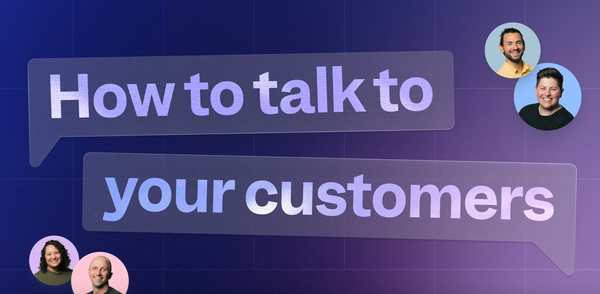Mastering Persuasion in Sales: From Pushing to Pulling
Introduction
Sales is a delicate dance of persuasion, where the key to success lies not just in understanding what prospects need but in how you uncover and address those needs. Traditional sales tactics often focus on pushing products and solutions, but the real magic happens when you pull – drawing out the prospect's own realization of their needs and the value you can provide. This blog explores the art of persuasive pulling in sales, illustrating how this approach can revolutionize your results.
The Problem with Pushing
Many sales representatives (AEs) fall into the trap of pushing their products or services. A typical scenario might look like this:
Prospect: "We want to streamline our business so that we don't have to manually upload invoices."
AE: "Well, it sounds like we'd be a fit and have exactly what you're looking for. Let's get you on a demo."
In this approach, any prospect needing "automation" or "streamlining" is seen as a fit, leading to a hard sell. However, this often results in prospects ghosting after the first call, follow-ups feeling flat and salesy, and clients churning soon after signing up.
Why Pushing Fails
The problem with pushing is that it focuses solely on the what of discovery – the information you need from the prospect. However, it neglects the how – the method of obtaining that information in a way that feels genuine and engaging. This leads to interactions that are transactional and salesy, which prospects can sense and are often put off by.
Shifting to Pulling
To overcome this, I started working with AEs on how to phrase their questions and statements to pull information from prospects, rather than pushing their sales agenda. This approach involves asking questions that prompt prospects to articulate their challenges and needs, essentially persuading themselves of the value you offer.
Here are two powerful questions that AEs began using to great effect:
1. "It seems like you've been managing relatively well, why not just continue doing what you're doing?"
This question encourages prospects to explain why their current situation is untenable, highlighting their pain points and the necessity for change. In essence, they end up selling you on why they need a solution.
2. "You mentioned that your timeline is next month, curious, why so soon, why not wait a little longer?"
This question prompts prospects to justify their urgency, reinforcing the immediate need for a solution and helping you understand their motivations better.
The Four Dimensions of Discovery
To master the art of pulling in sales, it's essential to understand the four dimensions of effective discovery:
**1. Surface-Level Discovery: This involves gathering basic information about the prospect's needs and challenges. It's the initial step where you identify what they're looking for and why.
**2. Contextual Discovery: This dimension goes deeper, exploring the broader context of the prospect's situation. Understand the underlying issues, the impact of these challenges on their business, and any previous attempts to address them.
**3. Emotional Discovery: This involves uncovering the emotional drivers behind the prospect's needs. What are their frustrations, fears, and aspirations? Connecting on an emotional level helps build rapport and trust.
**4. Strategic Discovery: Finally, strategic discovery involves aligning your solution with the prospect's long-term goals and objectives. How can your product or service help them achieve their broader business strategy?
Transforming Sales Performance
I've taught these four dimensions of discovery to hundreds of AEs, with remarkable results. Those who were put on performance improvement plans (PIPs) and followed this approach were able to turn their performance around. Others consistently hit 200% of their quota, even during economic downturns.
Case Study: Turning Pushing into Pulling
Consider the case of an AE who was struggling with high churn rates and low engagement from prospects. By shifting from a push to a pull approach, they transformed their interactions. Instead of immediately pitching their solution, they started asking probing questions that encouraged prospects to discuss their pain points and needs.
Prospect: "We want to automate our invoicing process."
AE: "It seems like you've been managing relatively well so far, why not just continue with your current process?"
Prospect: "Well, our current process is actually causing a lot of manual errors and delays, which is frustrating for our team and affects our cash flow."
By pulling this information, the AE was able to have a more meaningful conversation, addressing the prospect's specific pain points and demonstrating how their solution could alleviate these issues. This led to higher engagement, fewer ghosted calls, and significantly reduced churn rates.
Implementing the Pull Approach
To implement the pull approach in your sales process, consider the following steps:
1. Shift Your Mindset: Move away from a transactional mindset and focus on building genuine connections with prospects. Your goal is to understand their needs deeply and help them see the value of your solution for themselves.
2. Ask Open-Ended Questions: Use open-ended questions to encourage prospects to share more about their challenges and needs. Avoid yes/no questions that limit the conversation.
3. Listen Actively: Pay close attention to what prospects are saying, and use their responses to guide the conversation. Reflecting their words back to them shows that you understand and value their perspective.
4. Validate Their Concerns: Acknowledge the challenges and frustrations that prospects express. Validating their concerns builds trust and shows that you empathize with their situation.
5. Align with Their Goals: Ensure that your solution aligns with the prospect's broader business goals. Demonstrate how your product or service can help them achieve their strategic objectives.
Conclusion
Mastering the art of persuasion in sales requires a shift from pushing to pulling. By focusing on the four dimensions of discovery and asking insightful questions, you can engage prospects more effectively, build stronger relationships, and achieve better sales results. Remember, effective sales is about helping prospects see the value for themselves, not just telling them what they need. Embrace the pull approach, and watch your sales performance soar.


